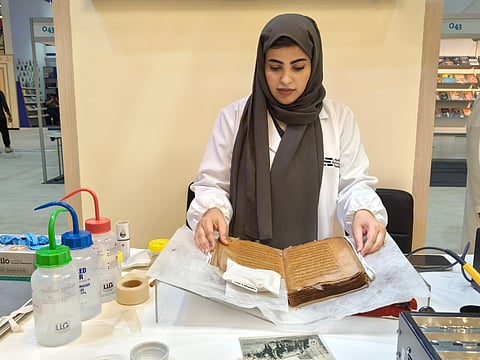From weeks to months: How UAE restores its priceless books at the National Library & Archives
Visitors to Sharjah International Book Fair can catch live demo

At the Sharjah International Book Fair, visitors watched in awe as Shaima Alameri, Restoration Specialist at the National Library and Archives (NLA) in Abu Dhabi, delicately inserted a thin piece of Japanese paper into an ancient book. It was a live demonstration of how the UAE safeguards centuries-old manuscripts and rare publications – a meticulous process that can take anywhere from a few weeks to six months.
“Whenever we receive a request for restoration or preservation, the first step is assessment,” Shaima said. “We carefully examine the condition of the book or manuscript to understand the type and extent of damage – whether it’s due to insects, fungus, stains or tears.”
Delicate art of book restoration
The National Library and Archives preserves a wide-ranging collection of rare books, manuscripts, and publications documenting the nation’s history, culture and development.
To eliminate insects invisible to the naked eye, conservators use a controlled fumigation process, replacing oxygen with nitrogen to ensure pests are safely removed without harming the paper.
“If there’s fungal damage, we treat it using alcohol or ethanol.”
Once the source of damage is identified, the team drafts a restoration plan detailing how the material will be treated.
“Sometimes there are missing areas or torn pages or stains. We clean everything first, then flatten the pages using gentle steam and weights,” Shaima said.
Japanese paper brings old pages back to life
Among the tools of her trade, Japanese paper holds a special place.
“It’s the most widely used material in restoration because it’s thin, strong, and compatible with old paper. It supports the missing or torn areas without affecting the original texture.”
After the repair work, each restored book is given a custom-made housing box for long-term preservation.
From fumigation to final binding
The time required varies with the level of damage.
“If it’s a simple case – just dust and small tears – it might take one to two months. Medium damage, like a broken spine or partial paper damage across hundreds of pages, takes around three to four months. But when we deal with severe damage, especially from fungus or when most pages are affected, it can take up to six months.”
For context, a single page may require two to four days of work, from cleaning and mending to final binding.
“So, if a book has 400 pages, you can imagine the time it takes,” Shaima smiled.
Embracing technology
While technology is playing an increasing role, the human touch remains irreplaceable.
“We use automated machines mainly for newspapers,” Shaima explained.
“These devices rely on water-based processes, which can damage the ink of delicate manuscripts. For books, we still prefer manual restoration.”
However, technology has enhanced diagnostic capabilities.
“We now have machines that can detect faded text or even reveal hidden watermarks – details invisible to the naked eye. They help us understand a document’s origin and authenticity without intrusive methods,” Shaima added.
The 2025 fair is underway at Expo Centre Sharjah and will continue until November 16.
Sign up for the Daily Briefing
Get the latest news and updates straight to your inbox


